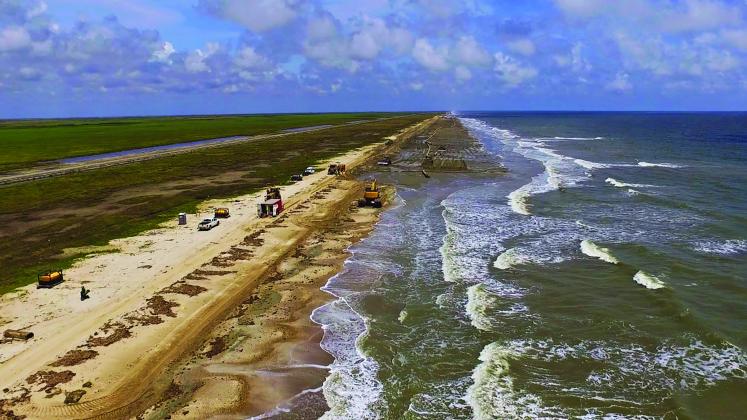Jefferson County residents, both human and animal, are set to be the beneficiaries of a National Oceanic and Atmospheric Administration (NOAA) project aimed at bolstering the area’s flood-prevention defense by restoring the dunes of McFaddin Beach.
After initially planning to start at the end of the 2021 hurricane season, officials weren’t able to begin approximately $96.6 million of “beach nourishment” until December 2021, according to a report from NOAA.
That “nourishment” includes dreding sand from the Gulf of Mexico seafloor and pumping it directly onto the beach to create sand “berms” – or raised barriers – to restore the beach’s natural flood-mitigation system. The restoration project is modeled after a 2017 pilot project, which restored 2.9 miles of shoreline in the same area.
The project’s aim is to restore and fortify approximately 17 miles of McFaddin National Wildlife Refuge’s beach dune ridge, specifically the area from High Island to Sea Rim State Park. Officials say the project will add approximately 150 feet of sand beach on the seaside of the dune, with a design life of at least 50 years. The sediment will then be graded to make new beaches and dunes. Once that work is completed, the contractor will plant native plants in the restored dune system.
“In December 2021, construction began on the Texas Trustee Implementation Group’s McFaddin Beach and Dune Restoration Project, which includes restoring approximately 17 miles of eroded shoreline along the southern edge of McFaddin National Wildlife Refuge,” read a February report released by the Deepwater Horizon Natural Resource Damage Assessment Trustee Council – a confluence of state and federal agencies aimed at researching and assessing the impact of the ecological disaster. “In order to continue making progress on the project, the Texas Trustees increased the budget originally approved in their 2017 Final Restoration Plan by approximately $2.5 million.
“The project will restore a beach and dune ridge barrier system that provides habitat for birds, and other beach and dune-dependent species. The new beach and dunes will also act as a restored barrier protecting interior wetlands and coastal habitats of the Salt Bayou watershed and the fish, invertebrates, and other life that use them. The interior Salt Bayou ecosystem has an array of different habitat types including: freshwater and saltwater marshes, coastal grassland prairies, submerged aquatic vegetation, tidal creeks and small bays.”
Officials say this diverse array of habitats creates an extremely productive area for fish and wildlife. They also provide outdoor recreational opportunities and are the first line of defense for coastal communities from tropical storm events. The Salt Bayou ecosystem is the largest continuous estuarine marsh complex in Texas.
In the United States, coastal erosion is responsible for roughly $500 million per year in coastal property loss, including damage to structures and loss of land, according to research conducted by the U.S. Global Change Research Program. To mitigate coastal erosion, the federal government spends an average of $150 million every year on beach nourishment and other shoreline erosion control measures. According to data from the McFaddin National Wildlife Refuge, the current rate of erosion averages between 15 and 45 feet of marsh habitat lost every year, and the bolstering of the area’s dune system will reduce that rate.
“The Chenier Plain is one of the most globally significant ecoregions that we have, really in all the western hemisphere,” wrote Carter Smith, director of the Texas Parks and Wildlife Department (TPWD). “This is one of the most important areas for wintering waterfowl, and wading birds and shorebirds in all of North America, particularly important as a larval or nursery area for finfish and shellfish. And of course the marshes and dunes play a critically important role in the resilience of these communities as the first line of defense against storm surges.
“Over decades the Chenier Plain has literally been nibbled to death by a thousand paper cuts. There are a myriad of challenges that are confronting this landscape... Within this six and a half-million acre landscape is some of the most valuable petrochemical infrastructure that we have in all of the United States. There’s no doubt that the stakes are high and certainly complacency is not an option.”



